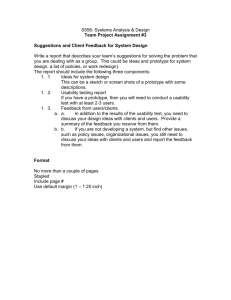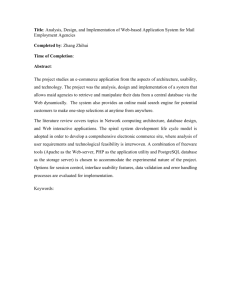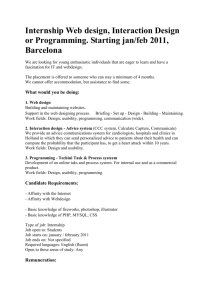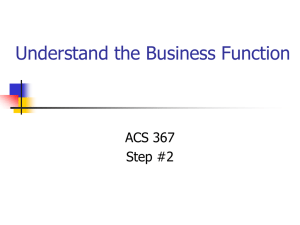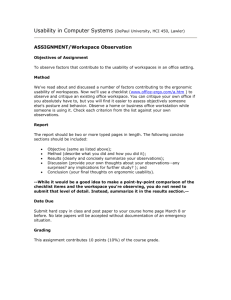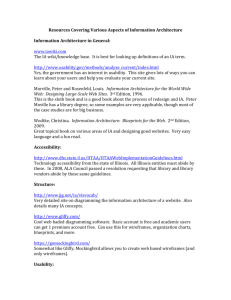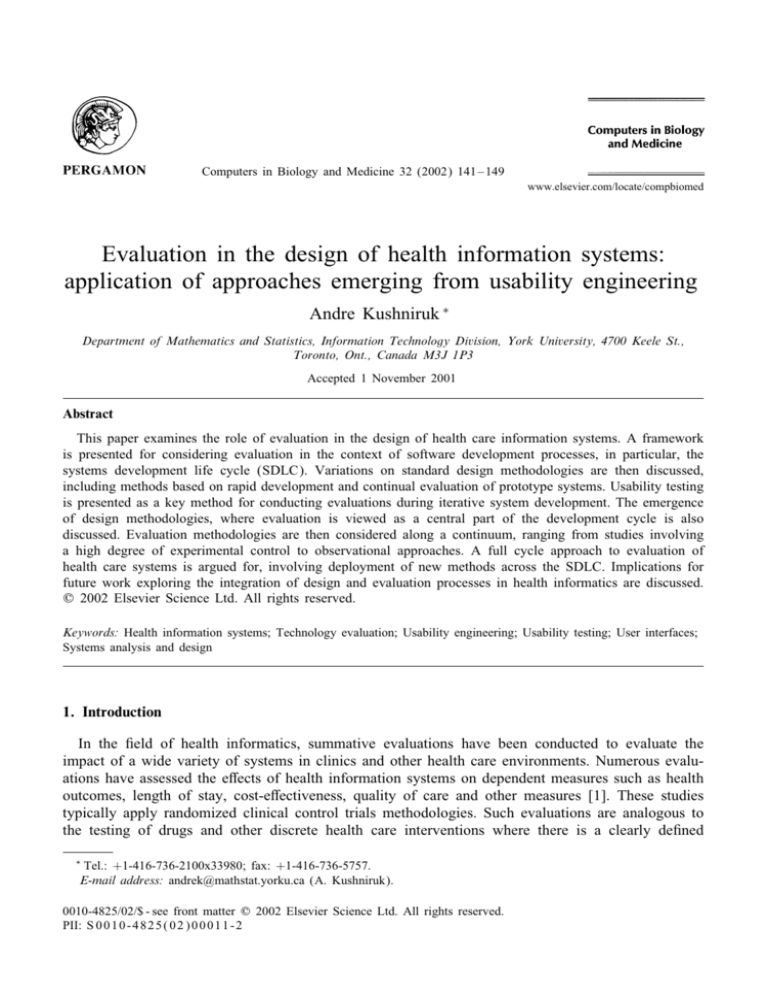
Computers in Biology and Medicine 32 (2002) 141 – 149
www.elsevier.com/locate/compbiomed
Evaluation in the design of health information systems:
application of approaches emerging from usability engineering
Andre Kushniruk ∗
Department of Mathematics and Statistics, Information Technology Division, York University, 4700 Keele St.,
Toronto, Ont., Canada M3J 1P3
Accepted 1 November 2001
Abstract
This paper examines the role of evaluation in the design of health care information systems. A framework
is presented for considering evaluation in the context of software development processes, in particular, the
systems development life cycle (SDLC). Variations on standard design methodologies are then discussed,
including methods based on rapid development and continual evaluation of prototype systems. Usability testing
is presented as a key method for conducting evaluations during iterative system development. The emergence
of design methodologies, where evaluation is viewed as a central part of the development cycle is also
discussed. Evaluation methodologies are then considered along a continuum, ranging from studies involving
a high degree of experimental control to observational approaches. A full cycle approach to evaluation of
health care systems is argued for, involving deployment of new methods across the SDLC. Implications for
future work exploring the integration of design and evaluation processes in health informatics are discussed.
? 2002 Elsevier Science Ltd. All rights reserved.
Keywords: Health information systems; Technology evaluation; Usability engineering; Usability testing; User interfaces;
Systems analysis and design
1. Introduction
In the 5eld of health informatics, summative evaluations have been conducted to evaluate the
impact of a wide variety of systems in clinics and other health care environments. Numerous evaluations have assessed the e7ects of health information systems on dependent measures such as health
outcomes, length of stay, cost-e7ectiveness, quality of care and other measures [1]. These studies
typically apply randomized clinical control trials methodologies. Such evaluations are analogous to
the testing of drugs and other discrete health care interventions where there is a clearly de5ned
∗
Tel.: +1-416-736-2100x33980; fax: +1-416-736-5757.
E-mail address: andrek@mathstat.yorku.ca (A. Kushniruk).
0010-4825/02/$ - see front matter ? 2002 Elsevier Science Ltd. All rights reserved.
PII: S 0 0 1 0 - 4 8 2 5 ( 0 2 ) 0 0 0 1 1 - 2
142
A. Kushniruk / Computers in Biology and Medicine 32 (2002) 141 – 149
independent variable (e.g., presence or absence of a drug, or in the case of health informatics studies,
presence or absence of an information system). Although these types of evaluations are necessary
in order to ensure that systems that are developed are both safe and e7ective, greater emphasis is
needed to ensure that the process of system design is e7ective. In addition, it can be argued that we
will not understand the full meaning of outcomes we obtain from the use of information technology,
unless we can understand outcomes in terms of the design decisions that lead to the outcomes.
A wide range of methodologies have been developed in the general software industry for providing
frameworks for designing information systems. Life cycle models provide a foundation for guiding
the development and evaluation of complex systems [2,3]. Traditional system development life cycles
(SDLC) presuppose a set of 5xed stages for system development, with evaluation of the system
predominantly occurring in the 5nal stages. Such approaches have proven diDcult to successfully
apply in health care where information needs may be hard to precisely determine. The possible
reasons for this are that the health care environment is often complex and characterized by missing
information, shifting goals and a great deal of uncertainty. Health care decision making processes
are complex, poorly understood and consequently diDcult to model e7ectively in the analysis of the
SDLC. Health care decisions are subject to a level of uncertainty not found in traditional business
environments and consequently health care technology and the knowledge on which it is based is
often very volatile. In fact, even before decision making processes are understood, they may change
within the time span of the traditional SDLC.
In recent years, a number of software engineering methodologies have been developed that focus upon deploying evaluation methods throughout the software life cycle—from an initial needs
analysis through to design and implementation, in addition to summative evaluation conducted upon
completion of the system. For purposes of developing an evaluation framework this paper will initially consider methodologies in terms of the traditional SDLC, followed by methods involving rapid
iterative development, based on a usability engineering approach. The traditional SDLC is characterized by the following phases: (1) planning, (2) analysis, (3) design, (4) implementation, and (5)
maintenance=support [2,3]. In this model each phase consists of similar activities that are somewhat
sequential, with one phase typically being completed prior to beginning the next phase.
A wide range of iterative design methods have appeared, where the distinction between the phases
has become blurred and the role of continual evaluation is emphasized. For example, methodologies
such as rapid application development (RAD) and various approaches to prototyping have become
increasingly popular as the basis for system development [3]. Using such approaches, system requirements are quickly converted to a prototype system that is iteratively revised, based on evaluations,
until an acceptable product is developed and the system is completed [3]. Continual evaluation is a
central component of these design methodologies. Along these lines, a greater emphasis on iterative
formative evaluation, closely integrated with the design and development process, has been called
for in the health care information technology industry [4]. In conjunction with this, deployment of a
wider range of methods for acquiring information relevant to design in health informatics evaluations
is also argued for.
2. Evaluation in the health information system development life cycle
Evaluation in health informatics spans a continuum from project planning to design and implementation. Fig. 1 relates a number of approaches that have been used in the evaluation of health
A. Kushniruk / Computers in Biology and Medicine 32 (2002) 141 – 149
1. Planning
(needs analysis)
2. Analysis
(requirements)
-workflow analysis
-job analysis
-analysis of
decision making
-interviews
-interviews
-questionnaires
-focus groups
-video analysis
-cognitive task
analysis
3. Design
-usability testing
-usability
inspection
-design walkthroughs
4. Implementation
(programming)
5. Support
(maintenance)
-usability testing
-code inspections
-software unit
testing
-outcome-based
evaluations
-randomized trials
-summative
evaluations
143
Fig. 1. The systems development life cycle (SDLC) in relation to evaluation methodologies.
information systems during the phases of the SDLC. For example, methods for analyzing work
activity (including workIow analysis and job analysis) are potentially essential components in the
initial assessment of user needs and system requirements early in system development. During the
analysis phase a number of evaluative methods may be employed, ranging from traditional systems
engineering methods (including observation, interviews and deployment of questionnaires) to formal
evaluations of work places in terms of socio-cognitive factors (including methods of cognitive task
and workIow analysis in the context of distributed collaborative activity [5,6]). During the design
and implementation phases a number of methods from the 5eld of usability engineering are becoming
increasingly more important when conducting formative system evaluations. As can be seen from
Fig. 1, formal summative evaluation comprises only one aspect of evaluation during the latter stages
of the cycle. In the larger computer software development industry emphasis is being placed on evaluation methods applied to a number of di7erent points in the SDLC. According to Friedman’s and
Wyatt’s framework for discussing evaluation in health care, many of these formative approaches fall
into the category of “subjectivist approaches” [1]. As will be discussed, the deployment and methods
of analyses associated with these methods, in particular usability testing, have become increasingly
re5ned and objecti5ed over the past few years.
3. The role of usability engineering in the evaluation of health care information systems
Important developments in software engineering have emerged with variations in the SDLC based
on principles of iterative design. A driving force in these advances has been the emergence of a
wide variety of information systems. Increasingly, the traditional SDLC, with its 5xed and rigid order
of phases, is being identi5ed as not being well suited to rapid development of highly interactive
Web-based applications [7]. For example, Web-based patient record systems, decision support and
educational applications constitute new forms of computer applications, that require innovative design
methodologies. In contrast to traditional systems applications (e.g., payroll, billing, etc.) many newer
applications may require continual, iterative feedback from potential end users and clients during both
design and development. There are a number of reasons why such applications may require continued
144
A. Kushniruk / Computers in Biology and Medicine 32 (2002) 141 – 149
Initial Systems Analysis
Basic Architectural
Design of System
Major
Changes
Needed
Design of Prototype
Prototype Implementation
Prototype Testing
(Usability Testing)
Redesign/
Modify
Based on
Evaluation
Evaluation
(Analysis of Results)
No
Results Adequate?
Yes
Final Implementation
Fig. 2. Systems development based on prototyping and iterative usability testing highlighting the role of evaluation in
system design.
user input, including the predominant role of the user interface in such highly interactive systems
(particularly Web-based systems), as well as the exploratory nature of many advanced applications,
where it may be impossible to fully specify what will be feasible or desired (in terms of features
and functionality) prior to starting system design.
The role of evaluation in iterative design and testing has been highlighted in many newer design
methodologies. Iteration in this context involves repeating or looping through the same development
activities, successively re5ning the system in each cycle. Typically this involves initial development
followed by evaluation and feedback into system design, leading to further cycles of evaluation and
redesign until a satisfactory system arises. In contrast to traditional SDLC, analysis is not 5nalized
at the beginning of system development, but recurs throughout the process.
Fig. 2 depicts a systems cycle based on the development of prototypes representing evolving
models that will lead to the 5nal software product. Prototype development and iterative evaluation
are embedded in this process. As shown in Fig. 2, iterative systems analysis and design is similar
to traditional design in that initial systems analysis is performed. However, the approaches diverge
considerably after the basic architectural design has been mapped out. At this point a prototype
is constructed. Prototypes vary from simple “mock ups” of the system design to partially working
models of the system that may contain some basic functionality [3]. The prototype is evaluated
during the design phase and further cycles of redesign and testing take place until the system meets
user expectations and 5nal implementation can take place (see Fig. 2). In this model of system
development evaluation is central. Evaluation spurs the development and continual redesign of the
system.
A. Kushniruk / Computers in Biology and Medicine 32 (2002) 141 – 149
145
3.1. Usability testing
Fig. 2 illustrates the role of evaluation in systems prototyping and the need for usability engineering. Perhaps the most powerful of these methods is usability testing. Usability testing refers
to the evaluation of information systems through the analysis of typical end users interacting with
the system. The phrase “discount usability engineering” was coined to describe the application of
low cost methods for conducting such tests [8]. More recently, a trend towards “virtual” usability engineering, involving remote testing, has emerged and will be described below [9]. The basic
strategy entails video recording all human–computer interaction (i.e., video recording all computer
screens) and audio-recording all subject verbalizations as they interact with system prototypes. Such
studies are being conducted using methods from experimental psychology, where subjects are asked
to “think aloud” while interacting with the system. Based on data collected from a representative
sample of subjects, typically involving as few as 8–10 participants per study, the majority of usability problems and issues can be identi5ed and summarized [10]. For example, subjects consisting
of representative users of a system (e.g., physicians or nurses) are asked to interact with a system
or prototype to perform a task, such as entering patient data. Subjects are also typically asked to
verbalize their thoughts while doing the task. The complete audio and video recording of the interaction can then be analyzed using methods involving the coding and classi5cation of user problems
(see [10] for details). The resulting information from such evaluation is summarized and presented
to the designers, allowing for iterative modi5cations to the system, as shown in Fig. 2. In the development of a complex system, there may be several cycles of design and testing involving usability
engineering before the system is completed. It has been reported that full usability testing can be
eDciently inserted into the design cycle of a patient record system, with a single initial cycle of
design-evaluation-redesign leading to as much as a ten-fold reduction in usability problems [10].
In health care, an increasing number of laboratories are applying usability engineering for formative
evaluation of information systems. A range of methodologies involving video-based analysis of user
interactions with prototype information systems have been developed [11–14]. Recent work has
included the application of remote usability testing for distance evaluation of Web-based health
care information systems. For example, tools that allow for remote access of end users’ screens
over the Web, can be used to make recordings of user interactions with a system under study [9].
Information collected from such process-centered evaluation can be used to redesign a system. This
information can include: (1) suggestions by users for improvements to both the user interface and
system functionality, (2) identi5cation of usability problems such as lack of consistency in interface
operations, and (3) quantitative measurements including time to task completion and system response
times [15]. Such methods were initially employed in the analysis of user interfaces. They can now
be used more broadly and can include experimental testing focusing on users’ satisfaction with basic
system functions or quality of information provided [16]. For example, in testing Web-based clinical
guidelines physician users may be encouraged (during usability testing) to comment on guideline
content and applicability to medical practice [9]. The results of such evaluation can then be fed
back into the redesign of the guideline format in order to increase uptake and satisfaction with the
information provided [9].
A usability engineering approach to system development is particularly appropriate when developing systems where user requirements may be diDcult to obtain using standard methods (such as
interviews and questionnaires) and technical feasibility for some system functions may be unknown or
146
A. Kushniruk / Computers in Biology and Medicine 32 (2002) 141 – 149
uncertain. Many of the more advanced applications in health informatics, including decision support
tools, patient record systems and educational tools are amenable to development using an iterative
approach, involving prototyping, as described above [10]. In addition, the availability of prototyping
tools, in particular Web-based development software, are making this approach increasingly attractive. In contrast, iterative methods may be less useful in developing systems characterized by a low
degree of interactivity (therefore requiring less input from end users) and more standard applications,
which can be based on design of previous systems (requiring less 5ne-tuning or adapting to particular end user needs). However, as health care applications inevitably become more complex and the
demand for customizing systems to particular user need increases, usability engineering methods are
likely to become critically important.
4. A continuum of methodological approaches to system evaluation
In the discussion above, approaches to evaluation in health care were considered within the context of development phases, from project planning to ultimate implementation and support. Considering evaluation from this perspective underlines the importance of evaluation throughout the
process of software development, and forms the basis for an increasing variety of evaluations in
health informatics. In this section, we consider a second dimension for evaluation based on the
type of evaluation method, ranging on a continuum from experimental to naturalistic=observational
methods, as depicted in Fig. 3. At one end are studies where an attempt is made to control all
factors in the evaluation and vary only a single independent variable (e.g., the presence or absence of an information system in evaluations attempting to follow a controlled trials approach).
There have also been a number of arguments made that a high degree of variable control may be
neither feasible nor desirable when testing systems in real-world contexts, in particular when attempting to achieve a greater degree of generalizability to complex real-world situations [17,18]. In
the context of usability studies, experimental approaches might involve laboratory testing of subjects
interacting with computer systems with only one or few variables (e.g., display format) manipulated
during the testing, with the test being conducted under controlled arti5cial conditions in a usability
laboratory.
Experimental
approaches
Simulation in
evaluation
-laboratory-based
usability testing
-conditions
manipulated
-low fidelity
simulators
-high fidelity
simulators
Naturalistic
approaches
-ethnographic
methods
-observation
-unobtrusive
recording
Fig. 3. A continuum of approaches to evaluation of health care information systems.
A. Kushniruk / Computers in Biology and Medicine 32 (2002) 141 – 149
147
From Fig. 3, it can be seen that evaluations involving simulation techniques are half-way along the
continuum ranging from controlled to naturalistic approaches. Evaluations based on simulations may
allow for a high degree of experimental control while also maintaining a high degree of realism in the
situations presented to subjects during testing (e.g., high 5delity computer-based simulations). Along
these lines, in a number of reported evaluations of computer patient records, physicians’ interactions
with the system under evaluation were recorded while the physician interviewed a “simulated patient”
(i.e., a collaborator playing the part of a patient to maintain a consistent stimulus) in an approach
modi5ed from usability testing [19]. Other forms of evaluation involving simulators could involve
the use of highly realistic computer-controlled mannequins, which serve as patients and respond to
inputs such as injections, for assessing areas such as operating room work activities and team decision
making involving advanced information technology [20]. These types of evaluations are similar to
those conducted in the aviation industry, where use of computer-controlled Iight simulators for
evaluating pilot learning and airplane construction have been routinely used to assess training [21].
At the other end of the continuum depicted in Fig. 3 are evaluative studies involving observational
and naturalistic approaches. From this perspective, activities and interactions with systems may be
monitored or recorded, using audio or video. Here the approach is designed to be as unobtrusive
as possible, with little or no experimental control. In areas such as the study of decision-making
in complex domains, the use of naturalistic study has been promoted by an increasing number of
researchers [22]. Proponents of naturalistic approaches to evaluation have argued that much of the
research from “classical” controlled experimental studies has not led to results that are generalizable
to real-world situations in complex domains [22].
Within the same set of evaluative studies it may be useful to begin at one end of the continuum,
for example conducting initial naturalistic observation of the e7ects of a patient record system that
is under development, and then move to studies that examine more precise variables under di7erent
(e.g., more controlled) conditions. In contrast, an evaluation of a health care system might begin
with a more obtrusive and controlled arti5cial approach, for example, usability testing of the system
with users in the laboratory. This work might lead to hypotheses as to the e7ect of system use
which could then be evaluated in the larger context of a clinic or hospital using observational or
naturalistic methods.
5. Discussion and future work
It is becoming increasingly acknowledged that there are a wide range of possible choices for
conducting evaluations in health informatics. This paper has presented a framework for considering
evaluation in terms of the SDLC and its variants. From this perspective, research in health informatics
evaluation needs to become more closely tied to emerging developments in systems engineering
(e.g., advances in methodologies such object-oriented analysis and design [23]). With developments
in systems and usability engineering, the interrelation between evaluation and design will continue
to become more complex. In general there has been a move from health informatics evaluations
focusing exclusively on measuring outcome variables to evaluations involving collection of in-depth
process data, for example, data collected on use of a system by subjects performing complex tasks.
This has led to a broader perspective on evaluation in health information systems than previously
proposed [1]. A challenge for future work will lie in the integration of data collected from multiple
148
A. Kushniruk / Computers in Biology and Medicine 32 (2002) 141 – 149
evaluation methods. This may involve conducting evaluations at several points during design and
implementation, as well as strategically varying the nature of the evaluation itself within a full
cycle of related studies. The complexity of health care environments and decision making will
necessitate application of new design methodologies that support an increased degree of user input
and evaluation.
An important area that will need to be addressed in future work is the potential relationship and
integration of methods focusing on examining process variables (e.g., usability testing) with methods
involving measurement of outcome variables, involving the use of more traditional approaches to
summative evaluation of health care systems. Furthermore, as the information technology we assess
inevitably becomes more complex, evaluation methodologies will need to be continually re5ned
in order to keep pace, making design and evaluation of e7ective health information systems a
challenging and continually evolving process. However, the greatest challenge to information system
development in health care, may well be improving our understanding of decision making in complex
health care environments.
Summary
This paper has considered the role of evaluation in the design of health care information systems.
It has been argued that evaluation must be considered throughout the entire systems development
life cycle (SDLC) in creating health care applications. Modern design methodologies based on rapid
development and iterative prototyping rely on formative evaluation in order to provide designers with
the input needed to improve systems. Methods emerging from the 5eld of usability engineering, in
particular usability testing, are essential for conducting such evaluations. The paper concludes with
a framework for considering evaluation methods ranging from controlled experimental approaches
to naturalistic observational approaches. Suggestions for further research in advancing the state of
evaluation in health informatics are discussed.
Acknowledgements
I wish to thank Dr. Vimla Patel and my colleagues from the Centre for Medical Education at
McGill University. Thanks for their support and encouragement during my years at McGill. I would
also like to thank James Cimino at Columbia University for his contributions and valuable advice
regarding many aspects of health informatics. In addition, I would like to acknowledge HEALNet for
its continued support. Finally, I would like to thank Elizabeth Borycki for editing drafts of this paper.
References
[1] C.P. Friedman, J.C. Wyatt, Evaluation Methods in Medical Informatics, Springer, New York, 1997.
[2] J.A. Ho7er, J.F. George, J.S. Valacich, Modern Systems Analysis and Design, Second Edition, Addison-Wesley,
Don Mills, Ont., 1999.
[3] S. McConnell, Rapid Development: Taming Wild Software Schedules, Microsoft Press, Redmond, Washington, 1996.
[4] A.W. Kushniruk, V.L. Patel, Cognitive evaluation of decision making processes and assessment of information
technology in medicine, Int. J. Med. Inform. 51 (1998) 83–90.
[5] V. Mehta, A. Kushniruk, S. Gauthier, Y. Richard, E. Deland, M. Veilleux, A. Grant, Use of evidence in the process
of practice change in a clinical team: a study forming part of the Autocontrol project. Int. J. Med. Inform. 51 (1998)
169–180.
A. Kushniruk / Computers in Biology and Medicine 32 (2002) 141 – 149
149
[6] V.L. Patel, A.W. Kushniruk, S. Yang, J.F. Yale, Impact of a computer-based patient record system on data collection,
knowledge organization and reasoning, J. Am. Med. Inform. Assoc. 7 (6) (2000) 569–585.
[7] J.J. Cimino, S.A. Socratous, Just tell me what you want!: the promise and perils of rapid prototyping with the World
Wide Web, in: J.J. Cimino (Ed.), Proceedings of the 1996 Fall AMIA, Hanley & Belfus Inc., Philadelphia, 1996,
pp. 719–723.
[8] J. Nielsen, Usability Engineering, Academic Press, New York, 1993.
[9] A.W. Kushniruk, C. Patel, V.L. Patel, J.J. Cimino, “Televaluation” of information systems: an integrative approach
to design and evaluation of Web-based systems. Int. J. Med. Inform. 61 (1) (2001) 45–70.
[10] A.W. Kushniruk, V.L. Patel, J.J. Cimino, Usability testing in medical informatics: cognitive approaches to evaluation
of information systems and user interfaces, in: D. Masys (Ed.), Proceedings of the 1997 AMIA Fall Symposium,
Hanley & Belfus Inc., Philadelphia, 1997, pp. 218–222.
[11] A. Kushniruk, V. Patel, Cognitive computer-based video analysis: its application in assessing the usability of medical
systems, in: R. Greenes, H. Peterson, D. Protti (Eds.), MED-INFO’95—the Eighth World Congress on Medical
Informatics, North-Holland, Amsterdam, 1995, pp. 1566–1569.
[12] A.W. Kushniruk, V.L. Patel, J.J. Cimino, R.A. Barrows, Cognitive evaluation of the user interface and vocabulary
of an outpatient information system, in: J. Cimino (Ed.), AMIA Fall Symposium Proceedings, Hanley & Belfus Inc.,
Philadelphia, 1996, pp. 22–26.
[13] P.L. Elkin, D.N. Mohr, M.S. Tuttle, W.G. Cole, G.E. Atkin, K. Keck, T.B. Fisk, B.H. Kaihoi, K.E. Lee, M.C.
Higgins, H.J. Suermondt, N. Olson, P.L. Claus, P.C. Carpenter, C.G. Chute, Standardized problem list generation,
utilizing the Mayo canonical vocabulary embedded within the Uni5ed Medical Language System, in: D. Masys (Ed.),
Proceedings of the 1997 AMIA Fall Symposium, Hanley & Belfus Inc., Philadelphia, 1997, 500 –504.
[14] J.M. Coble, J. Karat, M.J. Orland, M.G. Kahn, Iterative Usability Testing: ensuring a Usable Clinical Workstation,
in: D. Masys (Ed.), Proceedings of the 1997 AMIA Fall Symposium, Hanley & Belfus Inc., Philadelphia, 1997,
744 –748.
[15] J. Rubin, Handbook of Usability Testing, Wiley, New York, 1994.
[16] J.J. Cimino, V.L. Patel, A.W. Kushniruk, Studying the human-computer-terminology interface, J. Am. Med. Informat.
Assoc. 8 (2) (2001) 163–173.
[17] J. Orasanu, T. Connolly, The reinvention of decision making, in: G. Klein, J. Orasanu, R. Calderwood, C. Zsambok
(Eds.), Decision Making in Action, Ablex Publishing Company, Norwood, NJ, 1993, pp. 3–20.
[18] G.A. Klein, A recognition-primed decision (RPD) model of rapid decision making, in: G. Klein, J. Orasanu, R.
Calderwood, C. Zsambok (Eds.), Decision making in action, Ablex Publishing Company, Norwood, NJ, 1993, pp.
138–147.
[19] A.W. Kushniruk, D.R. Kaufman, V.L. Patel, Y. Levesque, P. Lottin, Assessment of a computerized patient record
system: a cognitive approach to evaluating an emerging medical technology. M.D. Comput. 13 (5) (1996) 406–415.
[20] D. Gaba, S.K. Howard, Situation awareness in anaesthesiology, Hum. Factors 37 (1) (1995) 20–31.
[21] J. Orasanu, E. Salas, Team decision making in complex environments, in: G. Klein, J. Orasanu, R. Calderwood, C.
Zsambok (Eds.), Decision Making in Action, Ablex Publishing Company, Norwood, NJ, 1993, pp. 327–345.
[22] C.E. Zsambok, G. Klein, Naturalistic Decision Making, Lawrence Erlbaum Associates Publishers, Mahwah, NJ, 1997.
[23] G. Booch, J. Rumbaugh, I. Jacobson, The Uni5ed Modeling Language User Guide, Addison-Wesley, Don Mills,
Ont., 1999.
Andre Kushniruk is an Associate Professor in Information Technology with expertise in the areas of health informatics, evaluation and
human–computer interaction in health care. He has written numerous papers on topics related to improving the usability of health care
information systems and has been a key researcher on a variety of collaborative projects in the areas of medical informatics and usability
engineering. His work includes the development of novel methods for conducting video analysis of computer users and he is currently
extending this research to the remote study of system usability. He has experience consulting on a variety of large projects with hospitals
throughout Canada and the United States in developing health care information systems. Dr. Kushniruk has taught at a number of
universities in Canada. He holds undergraduate degrees in Psychology and Biology, as well as a M.Sc. in Computer Science and a
Ph.D. in Cognitive Psychology. For the past ten years he has worked on health informatics related projects with a number of universities
including McGill University, Columbia University, the University of Victoria, the University of Toronto and Mt. Sinai Medical School.
Prior to his academic career, Dr. Kushniruk worked in industry developing innovative applications of knowledge-based systems.

